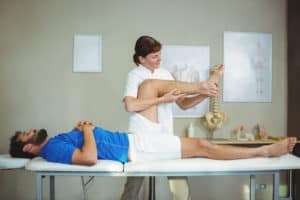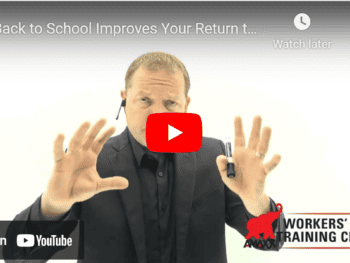When a physician is treating an employee for a back injury or other job related injury, the decision on when to return the injured employee to work is often a subjective decision. The physician who is unsure of the employees physical capability will often turn to the physical therapist for an objective opinion of the employees ability for work. The physical therapist will provide a Functional Capacity Evaluation (FCE) by administering various tests to determine the employee’s functional capacities and limitations.
Click Link to Access Free PDF Download
“13 Research Studies to Prove Value of Return-to-Work Program & Gain Stakeholder Buy-In”
Comprehensive Examination and Evaluation
The FCE is a comprehensive examination and evaluation by the physical therapist that objectively measures the employees level of functioning. The testing will document the employees ability, or the lack of ability, to perform the essential job related task over a specific time frame. The FCE will provide objective information to the physician in several areas:
- the employee’s functional abilities and job demands
- the disability evaluation
- when to return the employee to work
- whether or not the employee can return to the job held prior to the injury
- the employee’s functional abilities away from the job
- to information to design a rehabilitation plan, if needed
- the need for other medical intervention and/or treatment
While most workers compensation adjusters and employers will look at a FCE as a way of proving the employee is able to return to work, it serves a much greater function. The results of the FCE will often limit the disability rating of the employee, preventing the physician from assigning a higher disability rating than is justified. Furthermore, the FCE will determine physical limitations the employer will need to know to modify the employee’s job, preventing a needless re-injury of the same body part.
Job Specific & General Purpose FCE
There are two types of FCE, the Job Specific FCE, and the General Purpose FCE. The Job Specific FCE measures the employee’s ability to perform the task and physical demands of a specific job. It can be performed at the physical therapist’s clinic, but the physical therapists can go with the employee to the actual job site and evaluate the employee’s ability to do the essential task of the employee’s job. The job-specific FCE will determine if the employee can safely do his prior job or if modifications of the required work are needed.
The General Purpose FCE is normally used when there is no longer a job for the employee to return to or when the job functions have not been determined. The General Purpose FCE consists of a group of standardized test and measurements that can be used to establish the employee’s overall physical capabilities. The results of the General Purpose FCE can be used to evaluate the employee’s ability to perform specific jobs that may come available to the employee.
Determine Medical Status of Employee
Prior to starting the FCE, the physical therapist will review the medical records of the employee to determine the medical status of the employee. The physical therapist will establish a baseline for the employee based on the known job demands. The job demands of the employee will be characterized per the US Department of Labor’s “Selected Characteristics of Occupations as Defined in the Revised Dictionary of Occupational Titles” as:
- sedentary – exerting up to 10 pounds of force occasionally,
- light – exerting up to 20 pounds of force occasionally or up to 10 pounds of force frequently
- medium – exerting 20 to 50 pounds of force occasionally or 10 to 25 pound of force frequently
- heavy – exerting 50 to 100 pounds of force occasionally or 25 to 50 pounds of force frequently
- very heavy – exerting in excess of 100 pounds of force occasionally or in excess of 50 pounds of force frequently or in excess of 20 pounds of force constantly
Both the Job Specific FCE and the General Purpose FCE measure the employee’s ability to perform various motions, movements, and skills. The ability to do accomplish the physical demands of the job will be measured in these areas:
FREE DOWNLOAD: “13 Research Studies to Prove Value of Return-to-Work Program & Gain Stakeholder Buy-In”
- Balancing Carrying Climbing Crawling
- Crouching Far vision Feeling Finger dexterity
- Fingering Handling Hearing Kneeling
- Lifting Manual dexterity Motor coordination Near vision
- Pulling Pushing Reaching Sitting
- Standing Stooping Talking Walking
Again, using the US Department of Labor guidelines, the employee’s tolerance level during an eight hour work day for the above activities is categorized as:
- Not Present (Never) – The activity does not exist in the job (example: Crawling could be classified as Not Present in the job)
- Occasionally – The activity exists less than 1/3 of the time (example: Climbing – occasionally)
- Frequently – The activity exists from 1/3 to 2/3 of the time (example: Carrying – frequently)
- Constantly – The activity exists 2/3 or more of the time (example: Walking – constantly)
Document Evaluation Results
When performing the FCE, the physical therapist is responsible for ensuring the test are appropriate for the employee and the test can be done safely. The physical therapist will review the musculoskeletal condition of the employee as reported by the treating physician. The physical therapist will screen the employee for any underlying medical pathology that would limit or prohibit the employee from participating in the FCE.
Upon completion of the FCE, the physical therapist will document the evaluation results. The FCE report will confirm the employee can return to work without job modifications or will confirm the employee can return to work with specific job modifications, or the need to delay the employee’s return to work. The FCE may also address the need for work hardening or other interventions that would improve the employee’s physical abilities. Properly utilized, a FCE can provide the treating physician with the necessary information to return the employee back to work.

Contact: RShafer@ReduceYourWorkersComp.com.
Workers’ Comp Roundup Blog: https://blog.reduceyourworkerscomp.com/
©2018 Amaxx LLC. All rights reserved under International Copyright Law.
Do not use this information without independent verification. All state laws vary. You should consult with your insurance broker, attorney, or qualified professional.
















